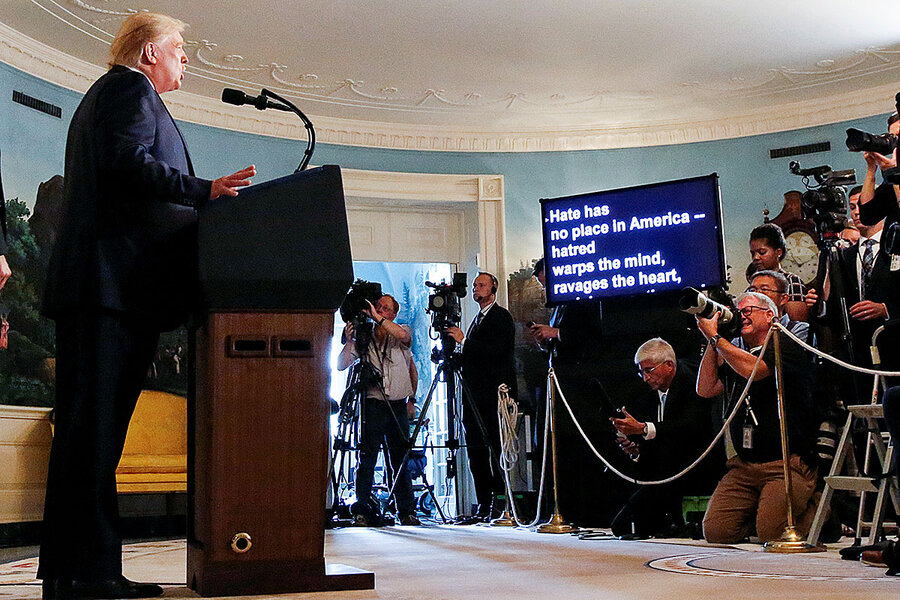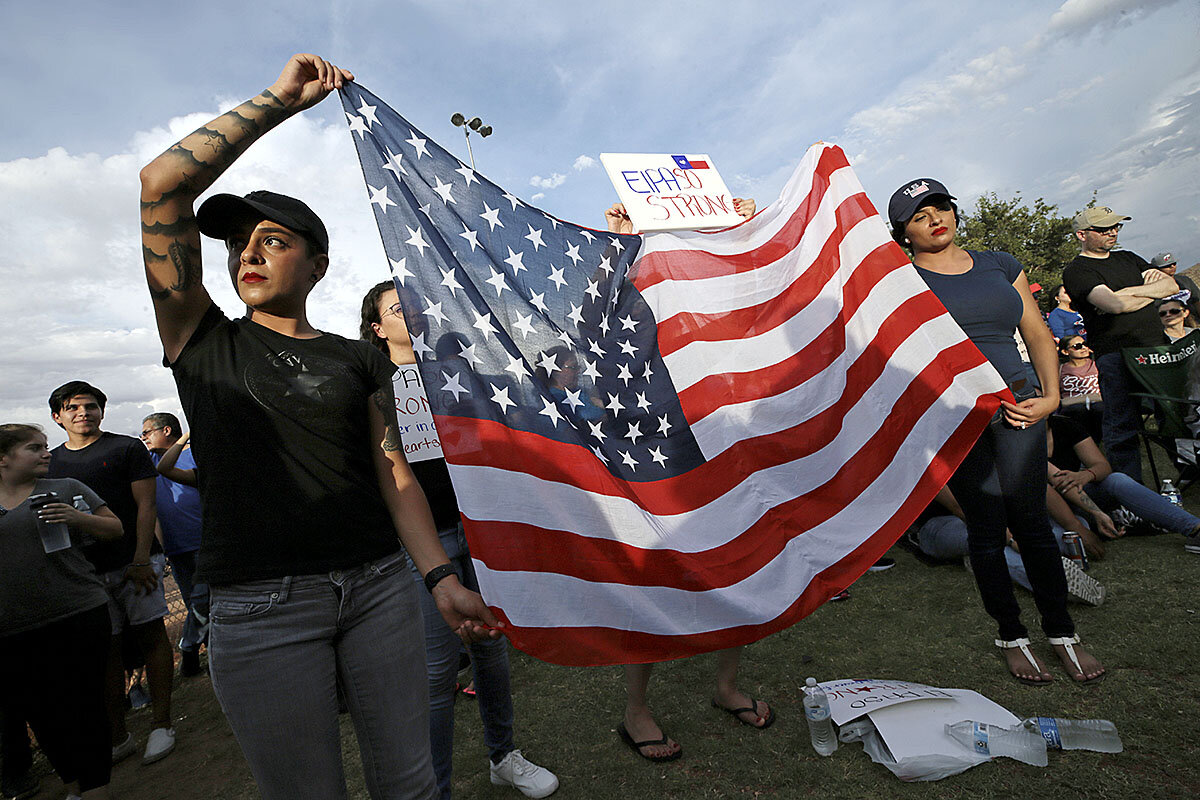El Paso: Rising white nationalist terror leaves its calling card
Loading...
| New York; and Savannah, Ga.
When Brian Levin talked to neo-Nazi extremists in the 1980s, many explained that singular acts of violence were like “branded messages.” They were meant to inspire those across the country who might share their views of white supremacy and the preservation of a white America.
“They called it ‘propaganda of the deed,’” says Mr. Levin, director of the Center for the Study of Hate & Extremism at California State University, San Bernardino. “And because this white supremacist movement favors leaderless resistance within its folklore, this notion was more about loners and small cells doing horrible, violent acts to bring the rest of the white community in with them, in order to stop the ‘degeneration’ of society.”
But in what he calls “propaganda of the deed 2.0,” American white supremacists, like their extremist counterparts in groups like Islamic State, have formed vast online networks. In the digital age, a symbolic ritual of violence is no longer enough, he and other terror experts say.
Why We Wrote This
Minority communities have long said killings by white nationalist extremists should be called terrorism. There’s now a willingness among law enforcement and some conservatives to do just that.
“Now you have to frame it and contextualize it on the internet,” Mr. Levin says. “It’s like these shooters are inscribing new chapters in this book of evil, while hoping there will be others to sign into the next chapter and the guestbook, as well.”
For many Americans, the word “terrorism” often evokes images of jihadist violence. But since last year, white supremacist terror has dominated headlines with mass shootings at the Tree of Life synagogue in Pittsburgh and the slaughter of 50 Muslim worshippers in Christchurch, New Zealand.
The mass shooting Saturday at a Walmart in El Paso, Texas, has become a tipping point for the country as it begins to come to grips with what even some Republican leaders are calling “white terrorism.”
The suspect allegedly cross-referenced his own manifesto with that of the Christchurch terrorist and, like him and others, posted on the social media site 8chan just before his rampage.
This weekend’s mass shootings, including the 22 people murdered in Texas and the nine shot and killed in Dayton, Ohio, have led many Americans to look more deeply at the troubling white supremacist subculture that has become more visible, and violent, in the past two years.
“The current administration as well as the previous administration have wanted to paint a picture of terrorism, that it only comes from overseas,” says Daryl Johnson, former analyst at the Department of Homeland Security and author of “Rightwing Resurgence.” “When it comes from within and [is] carried out by whites, it goes against what you want the public perception to be. And that, in turn, goes against the whole war on terror.”
Democrats have worried for years that zero-sum rhetoric about immigration could be inspiring to white domestic terrorists. On Monday, former President Barack Obama made a rare public statement urging rhetorical restraint and noting that nativist language encourages those “who see themselves obligated to act violently to preserve white supremacy.” All of us “have to behave with the values of tolerance and diversity that should be the hallmark of our democracy.” He also wrote that “both law enforcement and internet platforms need to come up with better strategies to reduce the influence of these hate groups.”
On Sunday, many Republican leaders, including Texas Land Commissioner George P. Bush, began to say that white nationalist terrorism is becoming a significant problem in the United States. Agreeing in a tweet, former Deputy Attorney General Rod Rosenstein wrote, “George is right. Killing random civilians to spread a political message is terrorism. FBI classifies it as domestic terrorism, but ‘white terrorism’ is more precise. Many of the killers are lone-wolf losers indoctrinated to hate through the internet, just like Islamic terrorists.”
Terror attacks around the world have receded since 2014, falling from about 17,000 in 2014 to about 11,000 in 2017, according to the University of Maryland’s Global Terrorism Database. In the Middle East, terror attacks have fallen almost 40%.
“They view America as a zero-sum game”
But the U.S. has seen a recent surge, experts say, led by a more visible and aggressive community of white supremacists and neo-Nazis. There were 65 terror-related incidents in the U.S. in 2017, up from 6 in 2006. Of these, 37 were tied to anti-Muslim, anti-Semitic, or other racist, xenophobic motivations, according to an analysis by Quartz.
“This generation of young white men don’t simply dislike the ‘other,’” says Juliette Kayyem, chair of the homeland security program at Harvard University’s Kennedy School of Government. “They view America as a zero-sum game, that the other is going to replace them.”
As she points out, many young white men understand that they are the last generation in the U.S. in which white births outnumbered those of minorities. As the Census Bureau reported seven years ago, minorities, led by Hispanics, were the majority of newborns in the U.S.
“This sense of the ‘great replacement’ is a core feature of what explains the violence,” says Professor Kayyem, a former assistant secretary at the Department of Homeland Security. “Essentially, it’s either them or me.”
And she and many others believe that the race-fueled rhetoric of President Donald Trump has helped to contribute to a political climate in which white supremacists feel emboldened to express their ideas about the threat the country’s fast-changing demographics pose to their vision of a white America.
“The fundamental problem is that Trump’s discourse is empowering lots and lots of people to believe that they have a right to hate, and some people are taking it as a right to strike out,” says Victor Asal, director of the Center for Policy Research at State University of New York at Albany.
In recent weeks, the president has mocked his opponents, tweeting that elected officials such as Minnesota Rep. Ilhan Omar and New York Rep. Alexandria Ocasio-Cortez should “go back to where they came from,” even as supporters at one of his rallies chanted “send her back.”
At a rally in Florida in May, as the president highlighted a caravan of immigrants heading toward the border, he rhetorically asked, “How do you stop these people?” Someone in the audience shouted, “Shoot them!” The president smirked, shook his head, and said, “That’s only in the Panhandle you can get away with that statement.”
But experts point out, too, that the growing number of terror-related incidents in the U.S. is not limited to neo-Nazi and white nationalist violence.
“If this stuff keeps going on, we may see responses of violence from the other direction, which would make it worse,” says Mr. Asal.
“What is so chilling is that, yes, white supremacy is most ascendant, but it is the most ascendant in a rising pool of extremism, including hard left and anti-fascist activity, and also heightened violent Salafi jihadism,” adds Mr. Levin.
Danger in making martyrs of criminals
Yet the country’s polarized political climate has in many ways made it more difficult to combat extremist violence on the right and left, many experts say.
The FBI struggles with addressing ideology, mostly because it is wary of making martyrs out of criminals, which can fuel violence. It is a mindset learned in part during the 1990s with the tragic results of the fire at the Branch Davidian compound in Waco, Texas, in which 76 people died, and the disastrous endgame at Ruby Ridge, Idaho, in which an FBI stakeout of a separatist family ended in the deaths of a U.S. marshal and a mother and son. Both incidents were cited by terrorist Timothy McVeigh as inspiration for the Oklahoma City bombing that killed 168 people.
“We chased the criminal tactics of terrorist suspects, rather than labeling them in a pejorative sense, which then gave them political standing,” says former FBI agent Michael German, who infiltrated right-wing extremist cells in the 1990s. “If you are a bomber or a murderer, we don’t have to discuss your political affiliations and give you that platform. If we make you a terrorist, we make you a martyr, and when we are making politics the front line of that conversation, we are undermining the rule of law, because it automatically doesn’t look fair.”
Condemning “racism, bigotry, and white supremacy” at a press conference on Monday, Mr. Trump said that “we are outraged and sickened by this monstrous evil.” In response to it, he opened the door to new gun restrictions, including broadening “red flag” laws that enable authorities to seize guns from unstable people.
But on Twitter, he claimed to his followers that the media – “Fake News” – and violent video games may be factors in the uptick of white terrorism on his watch.
“It is not out of our control to mobilize our counterterrorism resources to significantly suppress those who are moving toward violence on the far-right,” says Charles Strozier, founding director of the Center on Terrorism at John Jay College in New York. “We have that power in our hands.”
“The problem is that, politically, the way in which right-wing terrorism has been dealt with at the top, by Trump, is with ambivalence, which legitimizes the spread of hate and then generates on the margins the reality – not the possibility – of real violence by people who turn that political ideology into action,” Mr. Strozier continues.
After senior clergy at the National Cathedral chastised the president for a lack of moral leadership last week, the Rev. Dr. Leonard Hamlin Sr. had a different take Sunday as he tried to make sense of the violence and loss of life. “Our real challenge,” he told congregants, “is to look within. If you are honest ... all of us need to be transformed a little bit more.”






